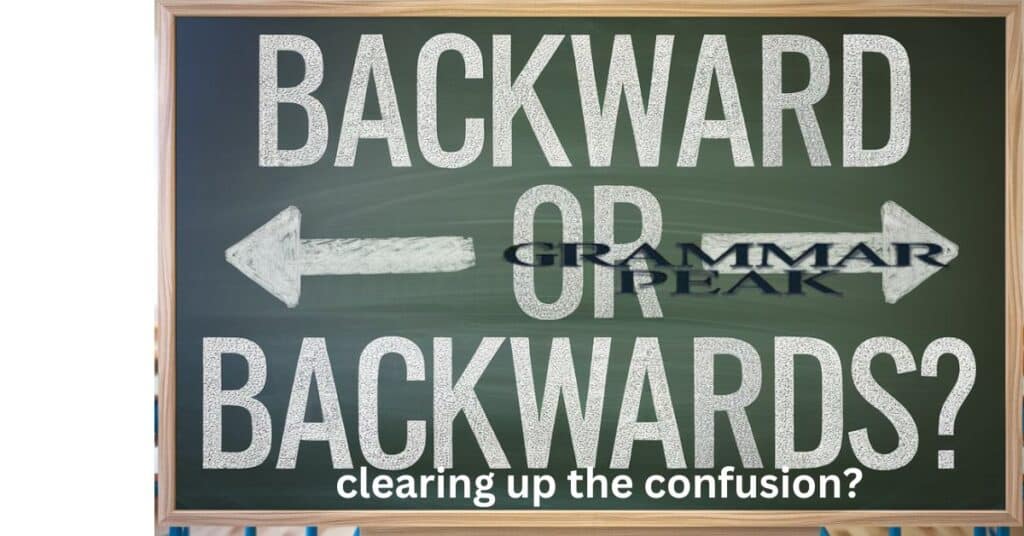Backward or backwards – which one is the correct way to write this common English word? This is a question that often stumps both native and non-native English speakers. The truth is, both “backward” and “backwards” are valid forms, but they have slightly different meanings and usages.
In this comprehensive guide, we’ll explore the nuances between these two words, their origins, regional preferences, and provide clear guidance on when to use each one. Understanding the difference between backward and backwards can be tricky. Many people wonder which form to use in their writing and speech. In this article, we will explore the distinctions between these two terms.
Why is There Confusion?
The confusion surrounding “backward” and “backwards” stems from their dual acceptance in the English language. Both terms are correct, yet they serve different grammatical roles. Backward is mainly an adjective that describes something oriented toward the back or in reverse direction, while backwards functions as an adverb, indicating how an action is performed.
This distinction can create uncertainty for writers and speakers alike. Moreover, regional preferences play a significant role in the usage of these words. In American English, people tend to favor “backward” more often, whereas in British English, “backwards” is frequently used.
This divergence can lead to misunderstandings, especially for those learning English as a second language or for those who switch between these dialects. Lastly, the overlap in meanings contributes to the confusion. In certain contexts, both words can be used interchangeably without altering the sentence’s meaning. For example, one might say, “She walked backward” or “She walked backwards.”
Explore these Backward or Backwards: Which is Correct?
What Does the Word “Backward” Mean?
The word “backward” is primarily used as an adjective to describe something oriented toward the back or moving in a reverse direction. For instance, you might say, “The car is moving backward,” indicating its motion away from its original position. This usage highlights the movement description associated with the term, emphasizing its role in defining spatial orientation.
In addition to physical movement, “backward” can also refer to a figurative context. For example, one might say, “He has a backward approach to technology,” suggesting that their methods are outdated or not progressive. This duality in meaning enriches the word, making it applicable in various situations, both literal and metaphorical.
What Does the Word “Backwards” Mean?
The word “backwards” is primarily used as an adverb to describe the action of moving or facing in a reverse direction. For example, you might say, “She walked backwards to avoid the obstacle.” This sentence illustrates how “backwards” conveys the idea of motion that is opposite to the forward direction.
It emphasizes the action of retreating or reversing one’s position, making it clear that the subject is not facing the intended direction of movement. In addition to physical movement, “backwards” can also apply to various contexts. For instance, you might hear someone say, “The clock is ticking backwards,” which indicates that time is perceived to be moving in reverse.
“Backward” vs “Backwards”: The Differences
Part of Speech:
- Backward: This term can function as an adjective. It is used to describe something that is directed toward the rear, such as in the phrase “a backward step.” It indicates a quality or condition related to reverse orientation.
- Backwards: This term primarily serves as an adverb. It describes how an action is performed, indicating movement in a reverse direction, as in “He drove backwards.” Its usage as an adjective is rare and generally not recognized in standard English.
Regional Preferences:
- In American English, the term “backward” is more commonly used for both the adjective and adverb forms. This preference reflects a tendency to favor the simpler form in various contexts, making it the go-to choice for describing reverse orientation or movement. For example, one might say, “He walked backward.”
- Conversely, in British English, “backwards” is more frequently used as the adverb form. This distinction highlights the regional variations in language usage, where British speakers often opt for “backwards” to describe actions performed in a reverse manner, such as in the sentence, “She looked backwards.” Understanding these preferences is essential for effective communication across different English-speaking regions.
Usage Context:
- The term “backward” is often employed in a more literal and physical sense to describe direction or orientation. For instance, it can refer to someone or something moving in a reverse direction, as in “He took a backward step.” This usage emphasizes the straightforward, tangible aspect of the word, making it suitable for describing actual movements or positions
.
- On the other hand, “backwards” is sometimes used in a more figurative sense to convey a mental or conceptual reversal. For example, one might say, “She is thinking backwards about the problem,” indicating a non-linear or regressive thought process. This figurative application allows for a broader interpretation of the term, extending its meaning beyond mere physical movement to encompass abstract ideas and reflections.
British English Words Ending in ‘s’ vs American English
| British English | American English |
| towards | toward |
| backwards | backward |
| forwards | forward |
| afterwards | afterward |
In general, British English tends to favor words ending in ‘s’, while American English more commonly uses the ‘ward’ ending. This distinction reflects broader trends in the variations between the two forms of English.
Read must be Backward or Backwards: Which is Correct?
Which One Should You Use: “Backward” or “Backwards”?
The choice between “backward” and “backwards” ultimately depends on the context and your target audience. If you’re writing for a primarily American audience, “backward” is generally the safer choice for both the adjective and adverb forms. This preference aligns with American English conventions, making it a straightforward option for clarity and consistency.
Conversely, if you’re addressing a British audience, “backwards” may be more appropriate as the adverb form. British English tends to favor this version, particularly in informal contexts. Understanding these regional preferences can enhance your writing’s effectiveness and ensure it resonates with the intended readers.
Examples in Context
Examples with “Backward”
- The car is moving backward to avoid the obstacle.
- She took a backward step to avoid the collision.
- The company’s sales figures have been trending backward for the past three quarters.
- He glanced backward to see if anyone was following him.
- The child fell backward when he lost his balance on the swing.
- The backward design of the chair makes it difficult to sit comfortably.
- In the game, players often need to move backward to dodge opponents.
- The team was criticized for their backward approach to problem-solving.
- She felt a sense of nostalgia when she looked backward at her childhood memories.
- The research indicates that the trend is moving backward rather than forward.
Examples with “Backwards”
- The clock is ticking backwards, indicating that time is running out.
- She walked backwards to keep an eye on the approaching danger.
- The company’s decision to restructure was a backwards step, leading to a decline in morale.
- He felt like he was moving backwards in his career after the recent changes.
- The presentation went backwards, as the speaker started from the conclusion instead of the introduction.
- They took backwards steps in negotiations, causing frustration among the team members.
- The toddler learned to walk backwards before mastering forward movement.
- The story unfolded backwards, revealing the ending first and then explaining the events that led to it.
- The athlete’s performance seemed to regress, running backwards compared to his previous records.
- She often found herself thinking backwards about her choices, wishing she had done things differently.
Synonyms and Similar Terms to “Backward” and “Backwards”
Synonyms for Both “Backward” and “Backwards”
Rearward:
- This term can replace both “backward” and “backwards” in many contexts. It describes something positioned or moving toward the back.
Example: “The dog moved in a rearward direction to get out of the way.”
Reverse:
- This term can also serve as a synonym for both “backward” and “backwards,” indicating a movement in the opposite direction.
Example: “He decided to reverse his car to parallel park more easily.”
Reversed:
- This term can be used as a synonym for both “backward” and “backwards,” often indicating that something has been turned around or oriented in the opposite direction.
Example: “The process was reversed, leading to a different outcome than expected.”
In Reverse:
- This phrase can act as a synonym for both “backward” and “backwards,” suggesting movement or operation in the opposite direction.
Example: “The vehicle was moving in reverse to avoid the traffic jam ahead.”
More Specific Alternatives
Retrograde:
- This term serves as a more specific alternative to describe movement or progress that is directed backward or in reverse.
Example: “The planet appeared to move in a retrograde motion, confusing astronomers.”
Retreating:
- This term can be used as a synonym for both “backward” and “backwards,” indicating a movement away from a position, often in response to pressure or danger.
Example: “The soldiers were retreating to safer ground as the enemy advanced.”
Aback:
- This term can be used as a synonym for both “backward” and “backwards,” typically indicating a position that is behind or to the rear. It is often used in the phrase “taken aback,” meaning surprised or startled.
Example: “She was taken aback by the sudden change in plans.”
In Retreat:
- This phrase can be used as a synonym for both “backward” and “backwards,” indicating a movement away from a position, often in response to pressure or a need for safety.
Example: “The troops were in retreat after facing overwhelming opposition.”
Origins of “Backward” and “Backward”
Origins of “Backward”
The word “backward” has its origins in the Old English term “bæcweard,” which is a combination of “bæc” (meaning “back”) and “weard” (meaning “toward”). This etymological formation indicates a direction towards the back or rear.
Over time, the term evolved through Middle English, where it was also represented as “arseward,” reflecting similar meanings related to directionality and position. By around the year 1300, the adverb “backward” became a recognized part of the English language, signifying not only physical movement but also metaphorical concepts of regression or lack of advancement.
Origins of “Backwards”
The word “backwards” is a more recent addition to the English language, emerging in the 16th century. It is formed by adding the adverbial suffix “-s” to the adjective “backward,” thereby creating the adverb form. This construction reflects a similar meaning to its predecessor, indicating movement or direction toward the back or rear.
While “backward” has been in use since the Middle English period, the introduction of “backwards” allowed for a nuanced distinction in usage, particularly in British English, where it is more commonly employed as an adverb. Both terms share a common etymological root, but the evolution of “backwards” highlights the dynamic nature of language and its adaptation over time.
FAQ” S
What is the difference between “backward” and “backwards”?
“Backward” can function as both an adjective and an adverb, while “backwards” is primarily used as an adverb.
When should I use “backward” vs “backwards”?
Use “backward” as an adjective and “backwards” as an adverb, especially in British English.
Is “backward” or “backwards” the correct spelling?
Both spellings are correct, but “backward” is more commonly used in American English.
How do “backward” and “backwards” differ in American English vs. British English?
In American English, “backward” is preferred for both adjective and adverb, while British English often uses “backwards” as an adverb.
Can “backward” and “backwards” be used interchangeably?
They can be used interchangeably as adverbs, but “backward” is the standard adjective form.
Conclusion
In summary, both “backward” and “backwards” are valid forms of the word, but they have slightly different meanings and usages. “Backward” is more commonly used as an adjective, while “backwards” is more frequently used as an adverb. The choice between the two ultimately depends on the context and your target audience, with “backward” being the safer choice for American English and “backwards” being more common in British English.

Mason Blake is an experienced blogger with a passion for language and communication. With years of expertise in crafting informative and engaging content, Mason shares valuable insights on grammar and writing. His clear, concise, and reader-friendly approach has earned him a loyal following, helping readers sharpen their language skills and master the art of effective communication.








Thanks for sharing. I read many of your blog posts, cool, your blog is very good.
Thanks for sharing. I read many of your blog posts, cool, your blog is very good.
Can you be more specific about the content of your article? After reading it, I still have some doubts. Hope you can help me.
Thank you for your sharing. I am worried that I lack creative ideas. It is your article that makes me full of hope. Thank you. But, I have a question, can you help me?
https://t.me/s/Official_1win_kanal/515
Thank you for your sharing. I am worried that I lack creative ideas. It is your article that makes me full of hope. Thank you. But, I have a question, can you help me? https://www.binance.com/pt-BR/join?ref=YY80CKRN
Thanks for sharing. I read many of your blog posts, cool, your blog is very good.